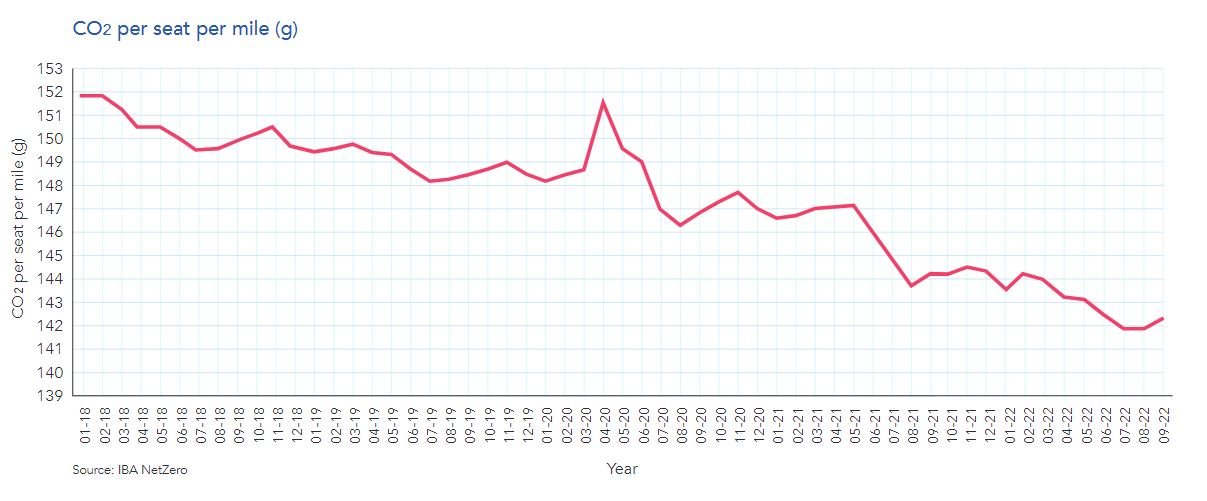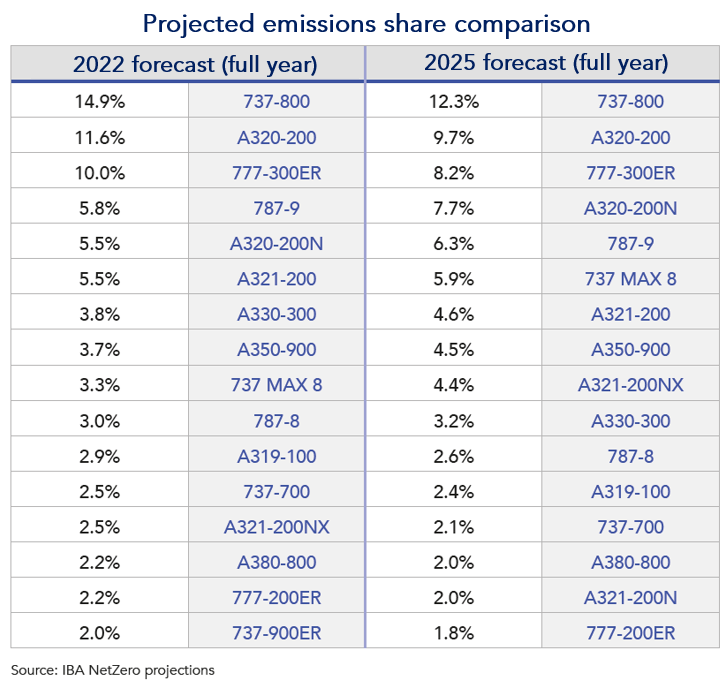18/10/2022
IBA has published its latest Aviation Carbon Emissions Index in partnership with KPMG. Its latest analysis uses IBA NetZero scenarios to forecast the likely spread of emissions across aircraft types in 2025 based on expected retirements and deliveries.
Aviation carbon emissions intelligence from IBA NetZero reveals that CO2 emissions from the commercial aviation industry averaged 142.25 grams of CO2 per-seat per-mile in September 2022, increasing by 0.2% month-on-month - the first month-on-month increase since February 2022. This represents a 1.3% reduction in CO2 intensity year-on-year.
The number of flights in September decreased by approximately 8.5% month-on-month resulting in a fall in total monthly passenger emissions from 59 to 54 million tonnes. However, total flights have increased by 17% year-on-year, tracking just 19% below the pre-pandemic levels of September 2019.

Chris Brown, Partner and Head of Strategy in Ireland, KPMG, shared his comments on developments in the EVTOL sector:
“Tailpipe CO2 emissions only contribute around 40% of the total airside climate forcing impact. That’s why we looked at the low hanging fruit in ground operations, including engine use in the taxi cycle in our recent thought leadership papers. We have also updated our ‘Air Taxi Readiness Index’ for 2022, highlighting the roles countries, lessors, and other players in smaller electric and hybrid aircraft helping to decarbonise the sector. Whilst our modelling suggests that only around 3% of all commercial aircraft energy needs will be met by electric solutions by 2050, this masks much higher penetration rates on some short-haul and regional routes. In our 2021 index, we foresaw both the entry into electric S/VTOL by existing lessors (think Avolon-e), as well as niche lessors drawn to this growing market as type and production certifications are granted.”
In the news: what happened in Global sustainable aviation in September 2022?
The US Department of Energy (DOE) released a roadmap towards net zero emissions by 2050, including plans to scale production technology, lower costs and improve sustainability of SAF in the American market. US airlines and the government have pledged to support the production of and purchase just over 10 billion litres of SAF by 2030. This equates to the US market committing to producing over a third of IATA’s SAF global production targets to reach Net-Zero by 2050.
Air Company, the SAF manufacturer, signed a multi-year agreement MoU with JetBlue and Virgin Atlantic, who have pledged to buy approximately 100 and 400 million litres of SAF respectively between 2027 and 2032.
Gevo announced its ground-breaking SAF 245 acre commercial-scale facility in South Dakota, with construction expected to start in 2023 and deliveries in 2025.
Aemetis finalised its $7 billion contract for 3.5 billion litres of blended SAF (40% SAF and 60% Jet fuel) with airline partners including Delta Air Lines, JetBlue Airlines and Oneworld Alliance airlines.
DG Fuels establish a new plan to deliver 200 million litres every year from 2027, for 7 years to Delta Air Lines.
United Airlines committed to invest $15 million on 200 eVTOL vehicles from EV Air Mobility
EasyJet set to abandon carbon offsets from December 2022, shifting focus to new aircraft and fuel saving technologies. EasyJet hopes to reduce its direct emissions by 78% by
OMV and Lufthansa signed a MoU to produce more than 800,000 tons of SAF between 2023 and 2030.
IATA expects global production of SAF to reach 5 billion litres by 2025, with the US government aiming to produce 11 billion litres by 2030.
Lufthansa Technik and BASF SE puts an emphasis on the use of the “AeroSHARK” or “Shark skin”, a film like material to install on the underbelly of the aircraft to reduce air friction, thereby reducing fuel consumption and by extension carbon emissions. “AeroSHARK” reportedly helps reduce air friction by 0.8% and could reach up to 3%. It has already been installed on all 10 of its 777F aircraft and on a 747-400. They are now looking to fit all the 12-strong 777 fleet with the skin technology, and this could lead to an approximate 1% reduction in carbon emissions.
New generation aircraft will drive improved efficiency
IBA used IBA NetZero to forecast the share of emissions by aircraft type in 2025. It combined the latest 6 months’ utilisation and global network activity with orderbooks and aircraft retirements from IBA Insight.
IBA’s projections show the Boeing 737-800, Airbus A320-200 and Boeing 777-300ER remain the highest absolute carbon emitters in 2025, but with their overall share reducing. Select new generation aircraft move up the rankings by 2025, including the Boeing 737 MAX 8, Airbus A321-200NX, and A321-200neo. This reflects the increased popularity of such types, especially the A321neo, thanks to their excellent efficiency improvements and suitability for operations.

-Ends-
About IBA NetZero
IBA NetZero is the most advanced finance-focused carbon modelling tool currently available; we’re leading the way. It’s powered by IBA’s proprietary fuel-burn intelligence which, when integrated with the Flights and Fleets module, can illustrate carbon emissions by any combination of: time period, airline, lessor, aircraft MSN and model, fleet, future portfolios, OEM, country, airport and route pair.
About IBA
IBA delivers the best of all worlds - deep aviation consultancy expertise, and cutting edge and actionable data insights, all delivered by a proven, expert team with a strong customer focus.
An independent, innovative and forward-thinking business, IBA has over 30 years of heritage and experience in aviation. Named 'Appraiser of the Year' by their clients for five years, and
most recently winning the Sustainable Technology award for its Carbon Emissions Calculator, IBA prides itself on its integrity, fierce independence, and continual innovation.
The key to IBA’s success is its people – some of the best in the industry, based in multiple locations across the globe – real experts who are passionate about aviation and go the extra mile for their clients.
IBA media contacts
Charlie Hampton / Faye Clarke
Email: [email protected] / [email protected]
Mobile: +44 (0)7884 187297